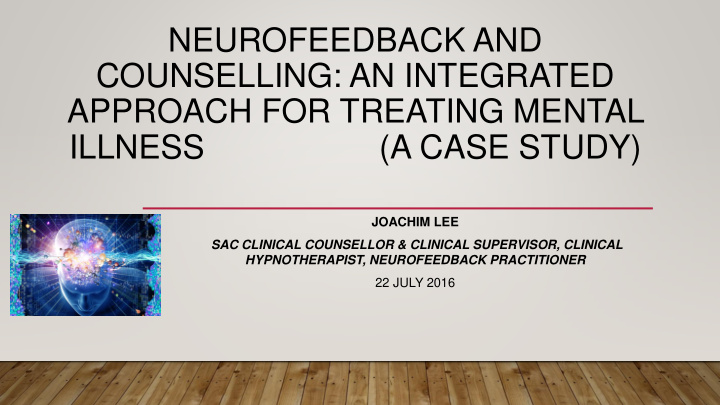



NEUROFEEDBACK AND COUNSELLING: AN INTEGRATED APPROACH FOR TREATING MENTAL ILLNESS (A CASE STUDY) JOACHIM LEE SAC CLINICAL COUNSELLOR & CLINICAL SUPERVISOR, CLINICAL HYPNOTHERAPIST, NEUROFEEDBACK PRACTITIONER 22 JULY 2016
Kate, 55, married with BACKGROUND TO CASE 4 adult children
DIAGNOSIS-SYMPTOMS-PSYCHOTROPIC DRUGS • Diagnosed 30 years ago PSYCHOTROPIC DRUG CONSUMPTION • Consumes 10 prescribed drugs Fluvoxamine 50 mg Depression -SSRI daily Diazepam 10 mg Anxiety • Suffers from severe drug side Haloperidol 1.5 mg Anti-psychotic / Treatment of effects, i.e. body stiffness, slow mania movements Benzhexol HCI 2 mg Antispasmodic-Pakinsonism • Psychiatric symptoms actively present Fluanxol 20 ml Anti-psychotic • Has developed immunity to CarbamaZepine 200 mg Anticonvulsant Psychotropic drugs • Requires monthly counselling sessions
CONSIDERATIONS FOR NEUROFEEDBACK (NFB) PROTOCOL WITHOUT QEEG NFB Considerations were based on: • Research Literature • Clinical Experience • Treatment Targets and Goals • Excluded two common protocols on NFB literature: Sebern Fisher Bliss Protocol - Training Theta and Reward Alpha at Cz Hammond’s Protocol -inhibit slow Alpha & Theta, Reward Beta at Fp1 & F3
MY THEORETICAL ORIENTATION: AN INTEGRATED APPROACH Neurofeedback Counselling - Protocol Bi-weekly Counselling sessions Sessions involved: CZ Delta C3 Delta C3 SMR - Psychotherapy (Strength and C3 – C4 C3 – C4 SMR Strategic based) Delta -Hypnotherapy
CLINICAL CONSIDERATIONS – MULTIPLIER EFFECT Change Objectives Control Objectives Ability to discriminate Anxiety Management Ability to develop higher levels of Suicidal Ideations ambiguity Ability to develop internal locus of Self Harm - OD control
NFB TREATMENT TARGET Adjunctive Tool for Training Brainwaves for Self-Regulation • Stabilize Delta Brainwaves at Cz • C3-C4 Sensory Motor Rhythm (SMR)
NEUROFEEDBACK SESSIONS Session Observations/Self Reporting Treatment No. Protocol 1-4 Irritated by the consistent pauses in the music Cz Delta 5-6 Reported to be calmer and pleased with the session C3 Delta Was motionless – Decreased in High Beta brainwaves 7-12 C3 SMR High Beta Increased and drop in SMR – Reported to be 13-19 C3-C4 SMR preoccupied with the trigger problem without affective symptoms 20 Came in being triggered by a crisis (SUD=9) C3-C4 Delta At end of session, SUD=5
CLINICAL OUTCOMES Pre-NeuroFeedback Post-NeuroFeedback Frequent Preoccupation with Trigger Decreased in number of preoccupations Problems Flooded with emotions – leading to Reported ability to contain negative affective Outpatient admittance for Fluanxol states Intravenous Low Tolerance to Ambiguity Shared examples (via counselling) of incidences where she was able to tolerate uncertainties Mental Processing Style-Emotional Frame Reported and observed ability to process information from a Cognitive Frame Over dependent on External Validation Able to slow down and listen to self for validation
CONCLUSION • Clinical evidence that current mental states can be shifted and new mental states reinforced via immediate feedback despite being on numerous psychotropic drugs • Frequent training in a specific mental state improves self-regulation • Clinical support through counselling increases internal wellness
LIMITATIONS OF NEUROFEEDBACK • Without QEEG – dependent on clinical assessment/experience of therapist • Cost – unaffordable for low and middle income clients • Requires 30 sessions and more • NFB for Mental Health – requires multi- disciplinary team
THANK YOU • Website: http://psychliving.com/ • joachimlee2007@gmail.com • +65 91705091
Recommend
More recommend